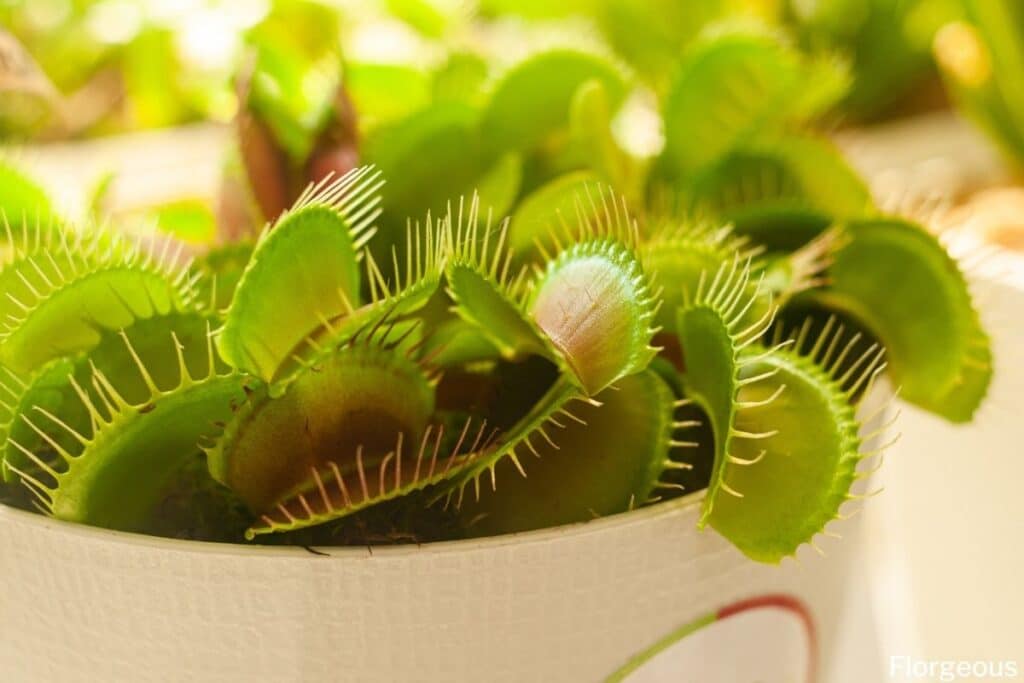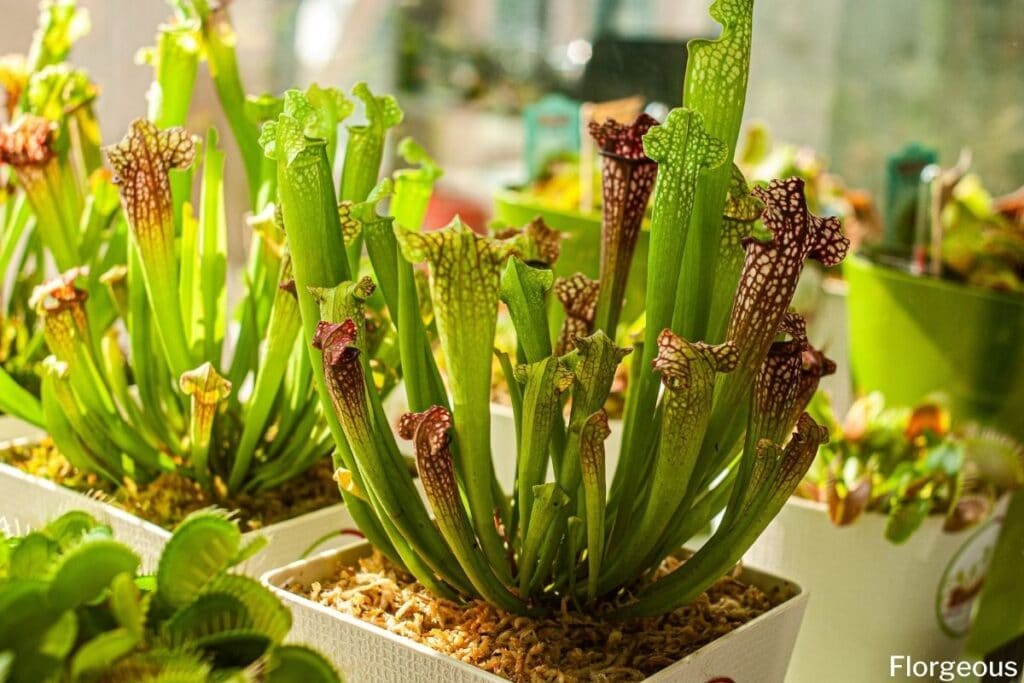It sounds like something out of the Little Shop of Horrors, but if you’re interested in learning how to grow and care for carnivorous plants, you don’t have to rely on the silver screen for all of your information.
We have everything you need right here! But first, what exactly is a carnivorous plant?
A carnivorous plant is a type of plant that eats insects and other small animals. These plants often live in bogs, marshes, and swamps where water levels tend to be low.
The soil is usually moist and nutrient-poor, which means these creatures have to find their own sources for food. The most common way they do this is by trapping prey with sticky hairs or an adhesive substance called “honeydew.”
Other species use toxins found in animal droppings as a form of protection against predators such as fungi and bacteria.
There are many different types that you can grow as houseplants, each of which has slightly different growing and care requirements. However, most share similar characteristics.
Ready to dive in? Here’s what you need to know about growing the most aggressive of all plant species – carnivorous plants!
Plant Facts
| Scientific name | Aldrovanda, Brocchinia, Byblis, Catopsis, Cephalotus, Darlingtonia, Dionaea, Drosera, Drosophyllum, Genlisea, Heliamphora, Nepenthes, Philcoxia, Pinguicula, Roridula, Sarracenia, Stylidium, Triantha, Triphyophyllum |
| Common names | Insectivorous plants, trumpet pitcher plant, Venus fly trap plants, sundew plants, etc. |
| Family | Varies |
| Plant Type | Houseplant |
| Height and Width | Varies |
| Origin | All continents except Antarctica |
| Flower colors | Varies |
| Foliage color | Varies (usually green) |
| Sun Exposure | Bright, indirect sunlight (usually) |
| Soil Type & pH | Neutral soil |
| Special features | High maintenance, no fertilization needed, require a wet environment |
How to Grow Carnivorous Plants
Each type of carnivorous plant is slightly different in terms of how to best grow and care for it. In general, these kinds of plants prefer swampy environments with lots of moisture and moss.
There are a few species that will survive outdoors in most temperate climates, so plan on growing your plant indoors. From sundews to pitcher plants, these growing requirements apply to most carnivorous plants.

Propagation
These plants can be propagated in various ways including by cuttings, tissue culture, and seed. It can be difficult to grow most species from seed, as many of these seeds become nonviable shortly after harvest. However, it is still possible if you purchase seeds from a respected source.
If you sow seeds, you can do so lightly on damp sphagnum moss or on another type of sterile plant tissue media. Orchid growing medium tends to work well for growers. Make sure the soil is disinfected before you plant, as the seeds are very vulnerable to contamination. The seeds can take up to two months to germinate and in some cases, it will be two years before you see mature plants.
Another option is to root cuttings in damp sphagnum moss. Put the cuttings in their containers in plastic bags with high humidity and moderate amounts of light. They’ll root in less than two months, with mature plants forming just a few months later. This is, by far, the fastest way to grow your own plants at home.
Soil
These species generally require a moist environment, since they’re naturally grown in wetlands and swamps. Generally speaking, they will not grow in commercial potting soil or any soil that contains fertilizers.
Plant your carnivorous plant in sphagnum moss when available, but if you can’t find it, peat moss or coco coir may also work. Again, you’re looking for something mostly neutral and devoid of nutrients. Though neutral soil is preferred, most species would rather the soil be more on the acidic side if otherwise.
Pruning
Most species do not need to be pruned. Some pitcher plants benefit from a little trimming when the leaves die off, as this can encourage more vigorous growth. Other than that, minimal maintenance is required.
Repotting and Transplanting
It isn’t very often that you will need to repot or transplant a carnivorous plant. For plants such as the pitcher plant, you will find that it needs to be repotted once the soilless mixture becomes shrunken and compacted. This doesn’t leave enough room for the plant’s roots to grow.
Repot when your plant is dormant, just before the spring. Remove as much planting medium as you can from the container, then make a new normal potting soil and water the mix to remove any air pockets. Gently place your pitcher plant into its new home.

Carnivorous Plant Care Guide
Caring for your plants can be a bit tricky, especially when you consider that these plants function differently than other types of plants. However, some general rules do apply to all species, as you’ll see in the tips below.
Water
These species like a lot of water. That’s why many gardeners choose to grow them in terrariums indoors. This will allow the plants to create their own self-contained microclimate where the heat, moisture, and light are all regulated by the plant.
Simply place your plant in its pot within the terrarium with the bottom of the pot submerged slightly in the water. The plant itself should be sitting above the waterline.
Try not to use water directly from the tap when you water carnivorous plants. It often tends to be too alkaline or has too many minerals. Use distilled water or rainwater instead.
Sunlight
These fascinating plants need bright, usually indirect, light. Most experts recommend using an artificial, ultraviolet grow light.
Most carnivorous species do not need to be placed directly in the sunlight during the summer months. This can be too hot and cause the leaves to become crispy. If you grow your plant under artificial lights, as recommended, keep them about four to seven inches away from the fluorescent lights.
You will know if your plants aren’t getting enough bright light because they will become spindly. In some cases, they may be discolored, too.
Temperature and Humidity
There is a wide range of acceptable temperatures when it comes to growing these houseplants. Some like to be kept extremely warm – the Venus flytrap, for instance, prefers temperatures of around 70 to 95 degrees Fahrenheit for most of the year but as old as 40 degrees Fahrenheit in the winter. Be sure to check the growing requirements for your individual plant.
Humidity is essential for most carnivorous species. Don’t let the plants stand constantly in water but consider submerging them in a shallow pool, as described above.
You can also house your indoor houseplants inside a terrarium or fish tank. The glass will help keep conditions warmer and more humid. Air circulation is still essential, so consider keeping a fan running in the room where you grow your plants.

Fertilizer
Carnivorous species get their nutrients from digesting insects, so usually, fertilizing is not necessary. They use appealing scents or leaves to trap insects (or sometimes sticky fluids) to imprison their prey – then, their digestive fluids absorb the nutrients from the food.
In most cases, you will not need to fertilize your healthy carnivorous plants in any way. The exception to this is if your indoor plants aren’t getting enough insects in a household environment (which is common in many cases, though surprisingly not as common as you might think).
If nutrition is an issue, fertilize your plants once a month with foliar spray diluted to one-tenth of its normal strength.
You may have to supplement your houseplants’ diet with insects. Usually, bugs will go in there on their own and most can survive for two months or so without any insects. However, if you’re growing indoors, you may have to feed carnivorous plants live insects every now and then.
Pest and Diseases
As you might expect, pests aren’t usually an issue for these plants! However, like all houseplants, you may occasionally see pests like whiteflies, mealybugs, or fungus gnats on your houseplant. Infestations tend to be mild, so feel free just to brush them off when you see them.
The only seriously problematic disease to watch out for is Sarracenia rhizome rot. It can kill the plant easily, especially if it’s already stressed. Keep an eye on moisture levels and reduce watering if your plant seems as though it is overly sodden.
Common Varieties and Cultivars
There are hundreds of different types of species, including members of various families, genera, and species.
Some of the most common types of carnivorous plants you can grow as houseplants include:
- Pitcher plants
- Venus flytraps
- Sundew plants
- Butterworts
- Lobster pot plants
FAQs
Are carnivorous plants hard to care for?
Yes, caring for carnivorous plants can be moderately challenging due to their specific requirements, but with proper knowledge and attention, they can thrive. Providing them with the right growing conditions, including appropriate soil, lighting, water, and humidity levels, is crucial for their well-being.
How do you keep carnivorous plants happy?
To keep carnivorous plants happy, mimic their natural habitat by ensuring they receive ample sunlight, using distilled or rainwater for watering to avoid mineral buildup, and maintaining high humidity levels. Additionally, avoid overfeeding or overhandling them, as this can stress the plants.
Do carnivorous plants like to be misted?
While misting can help increase humidity around carnivorous plants, it’s important to avoid over-misting, as excessive moisture on the foliage can lead to fungal issues or rot. Instead, monitor humidity levels and adjust misting frequency accordingly to maintain optimal conditions for your carnivorous plants.
Conclusion
If you’re looking for your next gardening challenge, you may want to consider growing carnivorous plants. The most common types are the Venus flytrap and the pitcher plant, but these are far from your only options.
No matter which type of plant you choose, you can rest assured that your houseplants will be some of the most fascinating and exciting plants you will ever grow in your home.







